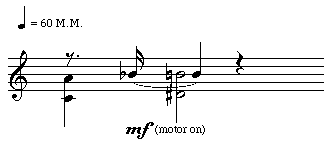Synthesis Theory
Course Outline (fall,
1999)
Resources
Assignment #10 (Due 99/12/14, all assigments are due 2pm)
Implement assignments #8 and #9 using Max/MSP.
Assignment #9 (Due 99/12/07, all assigments are due 2pm)
Using SC, create a reverb with adjustable reverb time and dry/wet slides
as well as input and ouput gain controls. You may use Alberto de Campo's
"Moorer/Loy Reverb for SC2" and James
McCartney's "Why SuperCollider" examples. See also James A. Moorer. 1979.
About this reverberation business. CMJ 3(2): 13-28.
Assignment #8 (Due 99/11/23, all assigments are due 2pm)
Using SC, create a 9-octave graphic equalizer: 50-100, 100-200, 200-400,
400-800, 800-1600, 1600-3200, 3200-6400, 6400-12800, 12800-22050Hz. Each
band should have adjustable Q.
Assignment #7 (Due 99/11/16, all assigments are due 2pm)
Using SuperCollider, write nice GUI demos of Amplitude Modulation and
Ring Modulation. They should, at least, have sin waves as the carrier and
the modulator. Other waveforms can be implemented optionally.
Assignment #6 (Due 99/11/04, all assigments are due 2pm)
Compose a 5-minute Csound composition using mostly Karplus-Strong
algorithm along with some AM, RM, FM, and waveshaping.
Assignment #5 (Due 99/10/14, all assigments are due 2pm)
Reproduce as accurately as possible, the following vibraphone excerpt.
Use additive, FM synthesis or vibes to simulate the
vibraphone sound. The
motor
should start up slowly. Note also that the B-flat is dampened by a
mallet.

Assignment #4 (Due 99/10/07, all assigments are due 2pm)
Produce the following with CSOUND:
- Repeat Assignment #3 using sawtooth generate by using 10 sine
oscillators and a
simple envelope using
linen
- Repeat above using one oscillator using sawtooth wavetable
lookup
- Repeat above using Trumpet-like sound using the information on
the
handout.
- Use only the steady-state amplitude
- Use time-varying dynamic envelope
- Use time-varying dynamic envelope and frequency change
Submit the hardcopy of the orch and score files and place a copy in
(314):Faculty:ich:synth:assignments99:#4
Assignment #3 (Due 99/09/30, all assigments are due 2pm)
Produce the following with CSOUND:
- Tempo M.M. = 100
- Use sine wave (GEN10)
- A = 440Hz

Hint:
Use the instrument of the form:
a1 oscil p4, p5, 1 ; where p4 is the amplitude and
; p5 is the frequency in the score file
Submit the hardcopy of the orch and score files and place a copy in
(314):Faculty:ich:synth:assignments99:#3
Assignment #2 (Due 98/09/23, all assigments are due 2pm)
Submit the result of this assignment on a CD and a hardcopy of
your comments.
- Record as best as possible the phrase "Short-time synthesis"
with your
own voice. "Short-time" should be spoken and "synthesis" should
be sung.
(Track 1)
- Record the same phrase in the same manner but in a very
noisy
environment, preferably outside (traffic noise). (Track 2)
- Using the Phase Vocoder in SoundHack and the sound of Track
1 do the
following. For each, provide two versions: a most natural and
intelligible
results and another which is to you most "interesting."
Document the
window type and the number of bins used for both versions and
submit a
hardcopy (start without using the Resynthesis Gating).
- Pitch-shift up 2 octaves (Tracks 3-4)
- Pitch-shift down 2 octaves (Tracks 5-6)
- Time-expand 3 times (Tracks 7-8)
- Time-shrink 3 times (Tracks 9-10)
- Repeat the last problem (#3) using Track 2 as the source.
In addition
to
documenting the window type and the number of bins, describe the
difference in the results compared to results using Track 1.
(Tracks
11-18)
- Use Track 3 and Pitch-shift down 2 octaves. Try to make it
as
close as possible to Track 1. Which settings gave you the best
results? What is the difference between this result and Track1?
What did
you lose? (Track 19)
- Repeat the last problem (#5) Use Track 9 and Time-expand 3
times.
(Track 20)
- Take the first 50ms of the "Sh" in "Short..." and
time-expand it 100
times. Document your settings. Use Resynthesis Gating for best
results.(Track 21).
Assignment
#1
(Due 99/09/16, all assigments are due 2pm)
Record with Sound Designer 2-3 sec. of your voice (e.g. a word). Create
two soundfiles based on the above.
The firs file (mono) should countain: the original, normalized version,
reversed (unless otherwise noted, use the normalized version as the source
for the following), reduce gain by 50%, change EQ using Parmetric EQ,
change EQ using Graphic EQ, Compress/Limit, Expand (the compressed
version), Noise Gate (the expanded version), Lengthen by factor of two
without changing the pitch, Shorten by factor of two, and shift up by 120
cents. Each section should be preceded by a short verbal explanation of
what follows.
The second file (stereo) should be a 30-60 second composition using only
the original sound of your voice.
Submit a Zip disk or a CD.
 Ichiro
Fujinaga 1999.09.08
Ichiro
Fujinaga 1999.09.08


